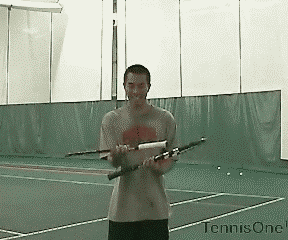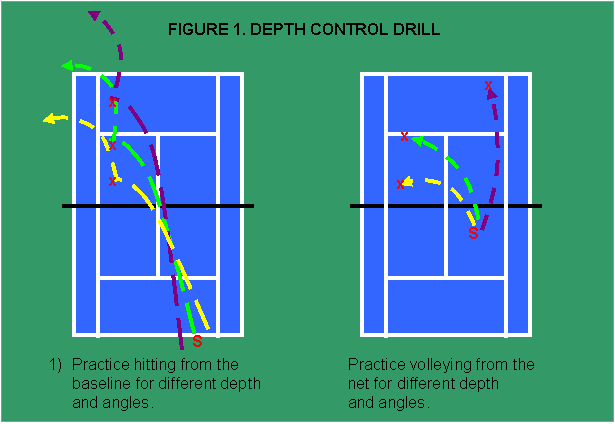|
TennisOne Lessons Developing Hands Doug Eng EdD, PhD Whenever I am asked what attributes are important in a great tennis player, I answer it takes many attributes such as a strong desire to succeed, great agility, willingness to get to every ball, or very good flexibility. But one of my favorites -- and I'm sure the same is true for many pros -- is developing good, soft hands.
Good, soft hands give a player a feel for the ball and the game. Tennis is most like creative artistry or child's play when you practice the feel of the game. The shots that use soft hands and accurate placement are often the shots that elicit jaw-dropping awes from spectators. We all wish we had the Sabatweeni (i.e., the between-the-leg-shot as Bud Collins named it), the Federer backhand drop shot or Nadal's amazing angled pass. Good, soft hands make tennis fun! I think it is important to develop these playful shots and tricks. One of my players' favorite tricks is what I call the Double Six-Shooter or the Gunslinger Trick. You can guess Geoff is ambidextrous. Hint: one of the fingers has to hook around the racquet. Cute shots don't become extremely useful by themselves in a real match but the skills they develop are necessary for the foundations of an all-court player. A player with great touch and feel will develop to ability to stay in a rally longer, make less mistakes in awkward court positions, and even create shots out of nowhere. The ability to extend a rally is often said to be due to a player's mental toughness or foot speed. But it is extremely important to have great hands and ball control to make a saving shot off an overhead or retrieve the ball inches off the ground. We think of Rafael Nadal as a great scrambler and heavy hitter but he has terrific hands. He has excellent drop shots, can play spectacular angles — even at ankle-height with his two-hander, and rarely makes mistakes. What we don't realize is that terrific hands allow you to play great defense such as making reaction volleys and returning big serves or overheads. Here are some tips to develop soft hands:
Now, let's go over some drills that can help you become a better racquet magician! One of the important aspects of good hands is accuracy. Feel involves not only knowing how much pace you can put on the ball but how close to the lines you can play, like threading a needle. If you don't have great control, pace, or feel for the contact point, you can't place the ball accurately down the line. In addition, feel for depth is very important particularly on slice approach shots. The Racquet Backboard Drill, is a great way to develop very light feel and control. Have a partner hold a racquet close to the net and practice playing mini-tennis using your friend's racquet as the target. It is harder than it looks but is definitely a great deal of fun once you get the idea. Another exercise you can try is the Depth Control Drill. In Figure 1, we see the drill from the A) baseline and B) net. In the diagrams, "x" marks where the ball bounces. You can start with a self-start or self-feed. Then have a partner feed you balls from the other side. Finally have your partner add pace to his or her shots. With increasing pace, you will find mastering hitting the targets will be harder.
I show three different depths and angles but you can practice with even four targets: 1) close to the net (e.g., drop shots), 2) inside the service line (angled or straight), 3) just behind the service line (e.g., chips and angled passes) and 4) finally within a yard of the baseline (e.g., deep groundstrokes and approach shots). You will need to control the height, spin, and pace of the ball. You may also have to play around with your grip. Most people never do this type of drill. They hit for power and aimlessly for depth without regards to feeling the ball.
Good hands also means fast hands and the Lightning Volley Drill is a great way to develop fast hands. For this drill, the feeder should be fairly skilled or have your pro try this with you. It's even more fun when you have three or four feeders, but you have to be organized otherwise it can be a bit unsafe. Your pro or friend should feed rapidly but medium-paced balls to allow good control by the hitter (or you). Using a hopper definitely helps. It is great for developing your volleys, fearlessness at the net, fast hands, and great hand-eye coordination. As I mentioned, I encourage lots of playfulness and experimenting with my players. A classic game that develops very soft hands is Ups shown in the fourth video. Both players should stand very close to the net. Start by dropping the ball from the top of the netstrap at the center. It may drop on either side and you may only use the service boxes as the court, ala mini-tennis. You can never hit down on the ball but volleying is fine. You can play drops, volleys, drop volleys, slice angles, and other playful soft shots. You will find yourself scrambling hard to get to the ball; and you will think mini-tennis is a great workout! A couple hints: use a continental grip and hold the racquet well in front (no need for the two hands on the racquet in the ready position). Also take a short backswing and use a bit of wrist to change directions at the last split-second to fool your opponent.
In addition, try practicing your drop shots, drop volleys, and stop volleys. I think of a drop volley as a soft underspin volley but the stop volley is a quick softening shot that takes the pace off a hard hit shot at the net and drops softly across the net. A drop volley is easier to play on a low ball that is coming down on to your racquet. The stop volley is a quick jab at the ball; when you are stretched wide, it is an advanced shot that players like John McEnroe or Patrick Rafter made famous. Most people don't practice these shots. I used to drive one pro friend nuts by practicing lots of volley drops at the net in the warm-up. I practiced up to the point where about one in four shots would come backwards over the net after the bounce. (I know some players who can do it with much more consistency!) Of course, it may not be highly useful in a match but it's a great exercise to practice to develop your hands. And many players, even pros, will play volley drops (and drops) typically for a half dozen winning shots in a match. When you practice the drop volley, use a very soft grip. Let the racquet face open gently as you make contact. The racquet may even move backwards. The stop volley is very similar to a drop volley. The drop volley has deliberately more underspin but the stop volley can be very spectacular since it is typically played when your opponent nails a hard passing shot a bit wide and high away from you. Just reach out and touch the ball so it gently makes it over the net. Avoid trying to swing or go forward with the racquet.
I had one player who was very good at doing this and when he played it in college matches, his opponents would turn red and fume (thinking what a lucky shot!) as the ball made its second bounce so very close to the net. It wasn't luck as he could pull it off very consistently. It is a feeling of helplessness when you rip a pass and your opponent stop volleys the ball barely over the net. There's no way you are getting to it! A final exercise for you is practicing to snag the ball. Here's a four-step progression to learn how to catch the ball on your strings. First, use an eastern backhand grip on the racquet so you are holding it like a frying pan. Then toss gently upwards and hold the racquet vertically and let the ball come down near the tip of the racquet. Let the racquet drop about at the same speed of the dropping ball. You can toss a bit higher or lower as in the video. Second, you and your friend should stand about ten to fifteen feet apart at the net. Have your friend toss you the ball underhand, a bit high and soft. Hold your racquet up vertically (using the eastern backhand grip). Then as the ball hits the top of the racquet, let the racquet slide down to your side. Let your arm move as one unit and let the elbow drop. A common mistake is to tense up and refuse to let the racquet drop by bending only the elbow and not letting the hand fall. Practice tossing and snagging to each other. Third, move back a couple feet and toss a bit less high and more horizontal to your partner. You may toss with a bit more velocity. Toss about three or four feet away from the body towards the forehand side. If you toss directly at each other, you'll find you'll get jammed as the elbow won't be able to go back. Let the hand and elbow go backwards behind your body. Your body will also turn a bit backwards. Use the racquet to slow down the ball.
Finally, have your friend stand behind the service line and volley-feed you balls to your forehand, three or four feet away from your body. Your friend should start with easy feeds and may add a bit more pace as you improve. The key, now as the ball is moving faster, is to relax and let the hand slide back and behind you. It is important to realize, that although soft hands can help you play cute shots, they are only one part of your game. Sometimes players get too carried away with touch and they get burned by a hustler who will run down the shot and rip it for a winner. Just as you won't crush every ball you hit (I hope not!), find a balance and maybe play a soft shot once every game or every other game depending on your style. A couple years ago Fernando Gonzalez was the ultimate ball crusher but he didn't get into a major finals until this year's Australian Open when he incorporated more control and slice as his coach, Larry Stefanki suggested. There are plenty of more fun tricks to do with the racquet. Get playful and try some of the cute shots. They will enhance your feel for the ball and the game. Best of luck this summer! Your comments are welcome. Let us know what you think about Doug Eng's article by emailing us here at TennisOne.
Doug Eng EdD PhD coaches men's tennis at Tufts University. During the summer, he directs at the Tennis Camps at Harvard. He has received divisional Pro of the Year honors from the PTR and USPTA and several national award. Doug completed the USTA High Performance Coaches program and frequently runs educational and training programs for coaches. Doug also writes and speaks on tennis and sport science. |



